°Arcus°
Home » Creation stories » Southwestern North America
CREATION STORIES FROM SOUTHWESTERN NORTH AMERICA
ACOMA
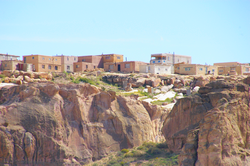
In the beginning, Uchtsiti created the world from a drop of his blood. The earliest life appeared underground: there was Tsichtinako or Sus'sistinako (Thinking Woman), along with two sister spirits who were formed within the darkness of a subterranean realm. Tsichtinako nurtured them, giving them language and baskets filled with the seeds of all plants and the forms of all animals, which were to come into being in the next world. These baskets were from Tsichtinako's father, Uchtsiti, the creator.
Among the seeds in the baskets were those of four trees, which were planted within the darkness. These eventually sprouted and one of them, a pine, grew enough to break a hole in the floor of the earth above to let in light. Then, the girls found the model of the Badger, to which they gave life. Badger was sent to dig around the hole to expand it, while ordering Badger not to enter the realm above. His reward was eternal happiness.
Thereafter, the model of the Locust was given life and tasked with smoothing the opening. He, however, disobeyed the sisters and peeked into the world above. He informed them that the land above was flat. For his disobediance, Locust was told that his people would die and be buried on a yearly basis.
Thereafter, Tsichtinako guided the four life forms into the world above. They awaited the coming of the sun in the east. They were taught a song of creation in the sun's honour, which they sang. The sisters were told to complete creation by giving life to the seeds and models in the baskets.
This being done, the sisters took the names Iatiku and Nautsiti, the Life-Bringer and Full Basket.
Eventually, the pair quarreled and Nautsiti bore two sons fathered by drops from the rainbow, which led to the desertion of the pair by Tsichtinako. One of the boys was raised by Iatiku, eventually marrying her. They became the parents of the first people. Iatiku was also responsible for bringing into being the class of spirits known as kachina.
AKIMEL O'ODHAM (PIMA)
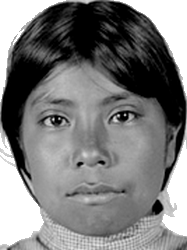
In the beginning, all was darkness and emptiness. This gathered together over the aeons to form a huge black mass. Over this, Earth Doctor drifted like a piece of cotton fluff in a breeze. Then, he decided to fashion a place where he could live. To this end, by his thought, he brought the creosote bush into being. However, after he had erected it, it fell over again. Only on the fourth attempt did it remain upright. Next, Earth Doctor took some dust from his chest and formed it into a flat cake. When it was still, he danced upon it, chanting a magical chant.
His next creation was a group of black insects, which made gum on the bush. He then made a termite, which worked with the flat cake until it grew and grew, becoming huge. Earth Doctor continued his dance, which stretched it further until it became the world. He then fashioned a round cover for it, the sky. In order to secure the earth against the shaking which had beset it as it stretched, he made a grey spider, which spun a web around the edges of earth and sky, fixing them in place. Thereafter, the earth became solid.
Next, Earth Doctor made the water, plants and mountains. He then illuminated the earth by making a dish, filling it with water and causing this to freeze. He threw it into the north, where it fell at the point where the earth and sky were joined together. This ball of ice began to shine, and is now known as the sun. It rose into the northern sky before falling back to earth. Next, Earth Doctor cast it into the furthest west, but again it slid back to the earth. The same happened in the south.
Finally, he threw it into the east, where it rose higher into the sky until it reached the canopy of the blue cover and slid down to the west again.
Thereafter, he formed the moon via the same process, and again threw it in each of the four directions until it began to retrace the westward course of the sun. Finally, he took some water and blew it into the sky to form the stars, which provide light in the absence of the sun and moon. He then took a magical crystal which he broke into pieces, making the larger stars. His walking stick was then dipped into ash which, when he threw it over the sky canopy, became the Milky Way.
Next, he set about populating the world with animals, before forming images of clay and telling them to become human. However, there were soon so many people that the food and water resources of the earth were at breaking point. There was no death. Eventually, the people resorted to cannibalism. Earth Doctor saw this and, realising the flaw in this creation, pulled down the sky to crush the inhabitants of earth. He made a hole through the earth and went through, emerging alone on the other side.
He called the sun and moon through and salvaged other material from the former earth. There was no sky, however, or stars. These he made anew, before creating another group of animals.
Coyote was born to the Moon and, when he had grown, he came to the domain of the Akimel O'odham. Later, Elder Brother was born to Earth and Sky. He was an overbearing chap, who spoke disrespectfully to Earth Doctor, who feared him. Again, the population increased, compelling Elder Brother to shorten their lives to avoid the overcrowding which had put paid to the prior creation. However, he disliked Earth Doctor's creation and planned to destroy humanity again.
To this end, he made a baby. This baby cried so loud the earth shook. Earth Doctor gathered the people and said there would be a flood. He bored a hole through the earth and enabled some of the people to escape. Some cried to Elder Brother to help them, but he did not answer them. He did, however, tell Coyote to fashion a raft from a log, while Elder Brother himself got into an olla and shut it tight.
A young man approached the baby, discovering that its tears were forming vast torrents of water which tore gorges through the earth. He picked up the child and both immediately became birds, a flicker and a vulture. They clung to the sky with their beaks to avoid the flood, but the tail of the former was washed by the waves. A god took pity on them and gave them the ability to make nests of down plucked from their chests, which allowed them to float.
South Doctor called his people and told them of the flood, boring a hole in the grown so his people could escape, while he sent others to Earth Doctor, who told them they were too late. The people were told to climb Crooked Mountain, which was protected from the waters by South Doctor tracing a line around it four times, before making use of his magic crystals.
Earth Doctor secreted himself within his reed staff, which floated, while Elder Brother rolled to the mouth of the Colorado River. His olla became Black Mountain. He contested with Coyote and Earth Doctor as to who was the first to appear after the flood, and they eventually agreed that it was him, enabling him to become ruler of the world.
Another story centres upon the creator Cherwit Make ("Earth-Maker"), the Great Butterfly, who formed men from his own sweat after descending from the realm of the clouds to the confluence of the Verde and Salt rivers. Again, the people proved highly adept at multiplying and eventually became selfish and quarrelsome, much to the chagrin of Cherwit Make, who felt that it might be best if he drowned them all.
He warned them by means of the winds, telling the Akimel O'odham of his plans. The shaman Suha heard what the North Wind told the people, but was disbelieved by his people. The East and South Winds repeated the warning to Suha, with the latter telling Suha that only he and his wife were worthy of salvation. Suha was cautioned to gashion a large ball of spruce gum to enable his wife and himself to have a refugium.
They did so and, after the flood washed all the other people away, their ark rested on what is today known as Superstition Mountain.
CHIRICAHUA APACHE
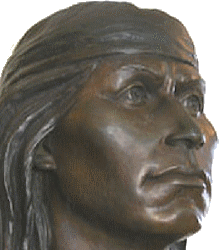
The earliest inhabitants of the earth knew nothing of the Great Spirit, revering instead the mountain-dwelling earth-spirits known as the Hactcin. This caused the Great Spirit a good deal of displeasure, which led him to send a deluge. The only survivors were on White-ringed Mountain. Turkey, the last up, had his tail feathers washed away. Eventually, the survivors descended, finding a gun and a bow. Two men were given the choice of these. The one who picked the former was the ancestor of the white man, while the one who chose the latter became the first Native American.
HOPI
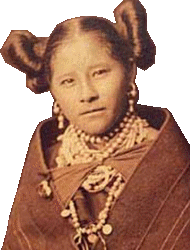
In general, the Hopi believe in two primordial beings. They held that Tawa controlled heaven, while Kótyangwúti - Spider Woman or Spider Grandmother - lived Under-the-World and held sway over the earth. The fullest account is that given in Frank Waters' Book of the Hopi - although Waters' material is to be treated with caution (it exhibits a number of rather 20th century concerns, for example), it is generally followed here.
In the beginning, Tawa was alone. Seeking companionship, he divided himself into Tawa and Muiyinwuh, or life-force, while Kótyangwúti or Kokyangwuti divided herself into Kótyangwúti and Huzruiwuhti, the goddess of life forms. Huzruiwuhti appears to be identical with Hurúing Wuhti ("Hard Beings Woman"), who began life as a hard surface from which the earth developed. Her kiva was located in the west and it was she who led the sun through a trap door into Under-the-World to find his way back to the east. Some say that she created the lord of agriculture, Muingwu, who appears as Muiyinwuh above. Another Hurúing Wuhti had her kiva in the ocean to the east.
Huzruiwuhti and Tawa produced the Holy Twins, Four Corners, Up, Down and the Great Serpent. Kótyangwúti and Tawa had a Sacred Thought, which decreed the placement of Up and Down in the midst of the Four Corners within the Eternal Waters. This Sacred Thought became the first song: -
The gods then placed a blanket over the newly-created beings and sung the Song of Life.
These were not, however, judged sufficient, and Tawa thought of creatures capable of ruling the new universe. Kótyangwúti transformed this thought into a man and woman. These - along with the remainder of the creatures - were ordered to multiply.
When sufficient numbers were achieved, Kótyangwúti led them up through the four portions of Under-the-World via the sipapu into the world at the centre of the Four Corners and Up and Down.
Kótyangwúti proceeded to divide the people into clans and villages, and instructed them in their mode of life. Among the knowledge imparted was the summoning of the Great Serpent, the bestower of rain and master of lightning.
TOKPELA - THE FIRST WORLD
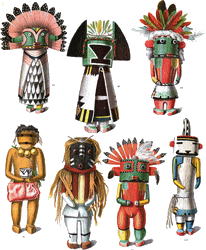
In Hopi tradition, the cosmos was formed from the primordial Tokpela ("endless space") by the action of the solar spirit Tawa or Taiowa. Tokpela was a void without any beginning, end, time, life or form outside of the mind of Tawa. In order to begin the process of ordering the universe, Tawa created Sótuknang, his "nephew," who was tasked with the demiurgic action of a secondary creator. He fashioned solidity from the intangible material of Tokpela, molding it into shape and arranging it into nine distinct regions: -
- one for Tawa;
- one for Sótuknang himself; and
- seven for the living beings which were yet to be created.
Sótuknang in turn formed and divided the waters and air according to his ninefold template by request of Tawa. His final task was to fashion life in order to conclude the four parts of Túwaquachi, Tawa's plan for the universe.
QOYANGNUPTI - THE PURPLE LIGHT OF CREATION
Sótuknang brought Kótyangwúti into being. She served as the creator's messenger and an intercessor between him and the people (NB in some versions it is she who creates all life). Kótyangwúti made a mixture of the four colours of the earth (white, black, red and yellow) with tüchvala and covered it with the white robe of wisdom, singing over them the Song of Creation, bringing to life the first men, four in number, in the image of Sótuknang, followed by the wúti, the first four women in her own image.
SIKANGNUQA - THE YELLOW LIGHT OF DAWN
These eight beings, animated by means of the breath of life, soon began to awaken and move around their world, though they remained damp on their foreheads, as well as retaining a fontanelle.
TALAWVA - THE RED LIGHT OF MORNING
At this point, the foreheads of the eight were fully dry, and their skulls had closed up. They stood up and, turning east, faced their Creator, Tawa. They were informed by Kótyangwúti that this was the sun, before she explained the significance of the three lights which had been present during these three stages: -
- Qoyangnupti represents the mystery of creation;
- Sikangnuqa represents the breath of life; and
- Talawva represents the warmth of love.
The newly-created humans are tasked to sing the Song of Creation in honour of Tawa. The song begins: -
Unfortunately, they are unable to speak, leading Kótyangwúti to task the echo twin Palongawhoya to seek answers from Sótuknang, who furnishes his aid. The people in the First World multiplied and were originally happy, living in primordial bliss, only for them to forget their duties towards Tawa. An individual by the name of Lavahóya ("Talker") appeared among them in the form of a Mochni (similar to a mockingbird) and, at his prompting, the humans and animals - who were of diverse forms and colours - became obsessed by the differences between them. Human society became increasingly focussed on skin colour and language, which caused the animals to shun them (their guardian spirit caused them to become wild and to fear humans).
Further seeds of discord were sown by one Káto'ya, a snake with a large head, the results of whose luring led humans to become increasingly suspicious of one another, leading to malice, accusations of wrongdoing and, eventually, fighting.
Those who remained obediant to Tawa's purposes were visited by Sótuknang, who told them to go to a certain place, to which their kópavi (centre of vibration on the tops of their heads) would lead them. They were to follow a cloud by day and a star by night, visible only to them, which would lead them to a gathering place, which turned out to be a mound where the Ant People. After the righteous had all gone down to live with the Ant People, Sótuknang proceeded to destroy the First World, using fire, as the Fire Clan had been the leaders.
TOKPA - THE SECOND WORLD
The Ant People - who possessed crystals imbued with the light of the sun which enabled the illumination of their realm - proved to be generous hosts, though eventually food supplies began to run low. Eventually, Sótuknang finished his work of fashioning the Second World, Topka ("Dark Midnight"), in which what was water in Tokpela was now land and vice versa. Tokpa was associated with blue, qöchásive (silver) and the south, and its chiefs were salvi (spruce), kwáhu (eagle) and kolíchiyaw (skunk). Again, humans began to multiply and cover the land, and again the seeds of discord were sown. This time it was through the beginnings of trade, starting out as simple bartering and ending up with most of the population, though they had an excess of all good material things, becoming greedy and covetous. Wars erupted between villages and again Sótuknang counselled those who remained true to their ancestral faith to leave to seek refuge with the Ant People. Subsequently, the twins Pöqánghoya and Palöngawhoya - who stood at the north and south of the world - were ordered to abandon their posts, which resulted in the earth spinning out of control. Topka was destroyed in a great conflagration, which resulted in the planet freezing into solid ice.
KUSKURZA - THE THIRD WORLD
While the remaining humans once again enjoyed the hospitality of the Ant People - and again the Ant People endured their presence with good grace - the earth remained frozen until Pöqánghoya and Palöngawhoya were told to resume their stations. The ice shattered and the earth once more began to rotate. As the earth warmed, Sótuknang called his people back out onto the surface. This Third World was named Kuskurza. Its colour was red and its direction east. Chiefs were palásiva (copper), píva (tobacco), angwusi (crow) and chöövio (antelope).
In Kuskurza, humanity achieved new heights in civilisation, developing large settlements worthy of the name of cities and dividing into countries. However, such a situation once more led them away from Tawa, with the population becoming preoccupied by their lives to the detriment of their religious obligations. The leaders of the people, the Bow Clan, developed some technological or magical marvels, including a pátuwvota, a shield which was capable of flight. Among the population was a wicked woman who boasted that she was earning so many turquoise necklaces from men in return for sexual favours that she could wind them around a ladder reaching to the top of the axis mundi. Those who continued to sing the praises of Tawa - which they did with renewed vigour - were ignored, the sounds of their melodies blotted out by the hubbub of the cities.
Nearing the end of this world, the states began an arms race, sparked by one group making use of a pátuwvota to launch an attack on a rival, before getting away as swift as the wind. Sótuknang, seeing this sad situation unfold, told Kótyangwúti to cut hollow reeds and to place the chosen few who would survive inside with supplies of hurúsuki (cornmeal dough) and water. This done, Sótuknang brought the Third World to an end through the medium of a flood.
AN ARDUOUS JOURNEY
The survivors of the deluge made their way up to the Fourth World via a sipapu - identified with the Grand Canyon - under Kótyangwúti's guidance. This was not, however, an easy journey.
Initially, the survivors found themselves on a tiny island in the midst of an all-encompassing sea. They sent out birds in search of land, then planted a reed which grew into the sky. This they clambered up, but still could see no trace of land. Kótyangwúti, following Sótuknang's prompting, orders the building of boats from the reeds which had carried the people to this place. They put out and, eventually, came to another rocky island, slightly bigger than the previous one.
Again they set out, in the direction of the rising sun, following a low, rumbling noise which they felt was associated with making landfall. This time, they came to a beautiful country with all manner of plant life. Kótyangwúti, however, informed them that this was not the place. They trudged to the eastern shore of the island and found the same type of reeds growing there as the one previously used to make their boats (which were now abandoned on the western side of the island). From these, they fashioned rafts and made paddles. This was, however, the beginning of an arduous journey in an east-north-easterly direction, which was described as being "uphill."
They came to another land, flat, long and broad, covered with plants bearing nuts and seeds. The group remained there for some years, before Kótyangwúti informed them that this was not the Fourth World which was to be their home, as it was "too easy and pleasant" a country for them, such that it would again cause their succumbing to temptation and evil doings. The way ahead would be even harder than it had been up to that point. The eastern shore reached, more rafts were made. At this point, Kótyangwúti informed them that she would not be joining them.
TÚWAQACHI - THE FOURTH WORLD
Now separated from Kótyangwúti, the surviving humans set out across the briny sea in search of the Fourth World, again heading east-north-east, again paddling as if going up a hill. Eventually, they saw a land rising high above the water, vast in extent. Making use of their inner wisdom, they knew that this was the Fourth World they sought. However, as they approached, they were disheartened to find that there was no landing place, for all of the coast of the land seemed to be precipitous cliffs. Eventually, they set off in a northerly direction before turning south when they found no sipapu there, only ever steeper mountains, ever more beetling cliffs. The south proved no more welcoming, whereupon they decided to make use of their kópavi to find inner guidance. Immediately, the water became calmer, and their rafts were found to be drifting along in a gentle current. They came to a sandy shoreline, and met Sótuknang, who welcomed them and showed them the way they had come. He reveals that the islands they had been to had been the tops of the mountains of Kuskurza, upon which they saw people. They watched as these sank beneath the waves, first the closest to them, then the rest in turn. Sótuknang explains that he has now washed away the footprints of their emergence, symbolically preventing them from backsliding into the dystopias which preceded them. They are informed that, should they continue to honour Tawa, these stepping stones would re-emerge as signs of the truth of their faith.
JICARILLA APACHE
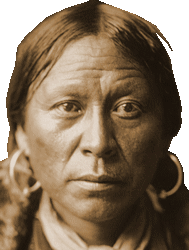
In the beginning, the Hactcin existed within dark, wet chaos. Feeling alone, he created the Earth Mother and Sky Father, as well as the people and animals from clay, giving them instructions as to their modes of life. He called down water from above and created the seeds of the various forms of plant life.
At that time, the earth was covered in water. The various creatures lived within the musty darkness of the underworld. This situation was fine for what would become nocturnal animals, but caused a great deal of dissention among the humans. Eventually, it was agreed that there would be a high-stakes game to determine whether or not there would be light or darkness. This involved finding a button by looking through a wooden thimble. The diurnal animals prevailed, which led to the award of the stars and sun. When the sun reached the apex of the underworld, he discovered a hole leading to the earth above.
When he informed the people of this, they wished to travel there, so built four mounds at the cardinal points and planted them with fruits and flowers. Eventually, two girls climbed the mounds to pick flowers, whereupon all growth came to an end.
This was insufficient to allow access to the hole, leading to the people asking the buffalo for aid. The buffalo lent its horns to be used as a ladder, the result of which was the curvature of the horns due to the excessive weight. The sun, moon and winds (one from each mound) were sent up first to cause the waters above to dissipate. The animals emerged first, followed by the people, who spread out and populated the land from sea to sea. The Jicarilla were the only people to remain in the vicinity of the hole, which led the Great Spirit to grant them this region at the centre of the earth.
KAWAIK
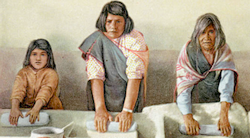
In the beginning, Tse che nako or Ts'its'tsi'nako (Thinking Woman or Old Spider Woman) created the universe, including the names and thoughts of all that would be - a process which brought them into being.
She was the mother or sister of twins, Uretsete and Naotsete, who continued the work of fashioning names and thoughts.
Eventually, the human race emerged from the underworld onto the surface of the earth.
KWTSAAN (YUMA)
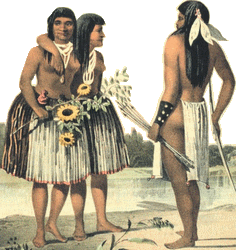
In the beginning, there was only water and void. From the waters arose a mist, which precipitated to form the sky. Within the deep was the formless Creator, who was born from these maternal waters in the form of twins: Kokomaht, the good twin, and his evil brother Bakotahl.
As he swam upwards, Kokomaht kept his eyes clenched closed, but told Bakotahl that they had been open. This led Bakotahl to keep his open and, as a result, he was struck blind. Next, Kokomaht made the four directions, taking four steps in each direction over the water and announcing their names. Thereafter, Kokomaht readied himself to create the world, but Bakotahl pleaded to have the first opportunity. Kokomaht refused and created land to live on by stirring the waters. Bakotahl sat down next to him on the land, and secretly fashioned a human shape from mud. Meanwhile, Kokomaht made a similar shape, the perfect man, followed by the perfect woman. When Bakotahl showed his brother his own work, Kokomaht proceeded to lecture him on the imperfections of his creation, which lacked hands and feet. Incensed, Bakotahl dove into the depths and sent storms to beset the land, which were easily put out by Kokomaht. Nevertheless, Bakotahl's actions led to the coming of sickness into the world.
The first people Kokomaht had made were the ancestors of the Kwtsaan, while Kokomaht also made the other tribes in the region, creating a total of twenty-four pairs before turning his hand to the making of the white people.
One final gift to the Kwtsaan was the creation of Komashtam'ho, a boy Kokomaht made in the void. He became a culture hero, instructing the Kwtsaan (and other tribes) on how to live and reproduce. Kokomaht now set about making the stars and moon to light the dark world, before telling the people that he was handing over the reigns of creation to Komashtam'ho.
Frog, however, had hatched a plan to kill Kokomaht, who knew of this but assented anyway. Frog slew Kokomaht by sucking out his breath. Mortally wounded, Kohomaht gathered all of the people around him bar the white man (who was too busy being overly-acquisitive and resentful of his ghostly-pale skin).
Komashtam'ho continued his father's work, making the sun, then wood, from which he made his father's pyre. He sent Coyote to retrieve a spark from the sun. Coyote, however, stole Kokomaht's heart as his body burned, which condemned him to live as a bandit. Komashtam'ho eventually made a horse from sticks for the white man.
Komashtam'ho was eventually succeeded by Marhokuvek, who was his nominated chief. He sent a flood to get rid of some of the worst aspects of creation, but the flood failed to discriminate between these and the righteous. Marhokuvek sought mercy and Komashtam'ho sent a fire to dry up the waters, creating the deserts in which the Kwtsaan live. Komashtam'ho turned himself into four eagles to watch his people.
LIPAN APACHE
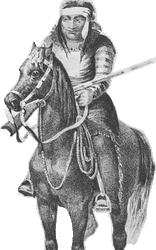
At the beginning of everything, people and animals lived beneath the earth in the dark lower world. They wondered if a better world existed and called a meeting to decide on a course of action. It was agreed that someone ought to set out on a journey of exploration. Wind was dispatched and went up to our world and blew away some of the waters which covered it at that time. He failed, however, to return with tidings of his travels.
Next, Crow was sent, but he didn't return either, staying above to pluck out the eyes of the dead fish he found on the newly-dry land. Beaver too remained above, building his dams.
Thereafter, the people sent Badger, who made the journey and returned with a full report. Finally, the Four Grandfathers - who became the first Native Americans - came up and arranged the world, by turning one of their number into a ball, from which they fashioned trees, streams and mountains. Then they called the people from the underworld above. Once they had all emerged onto this world, the people - who were led by the Sun, Killer of Enemies and the Moon, Changing Woman - began wandering, forming tribes. The last of all were the Lipan.
MESCALERO APACHE
The Mescalero tell of the Four Grandfathers, each of whom stands at one of the cardinal directions, holding up the universe. Some Apache stories tell that the Four Grandfathers were opposed by the Wind, which blew the earth over on several occations.
MOJAVE
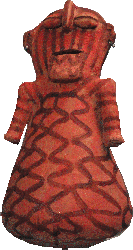
In the beginning, the world and all that is in it was created by Matevilya, who was the product of the union of the Earth Mother and Sky Father. Matevilya then gave the people their names, and taught them his laws.
Matevilya had a son, Mastamho, who gave the people the river and taught the arts of agriculature. He formed the Colorado River by plunging a cane formed of breath and saliva into the earth, before riding down the course of the new stream in a canoe. He was the brother of Kaatar and Frog. Frog, upset by an indiscretion on his part, slew Matevilya, who was cremated.
Eventually, after his journey down the Colorado River, Mastamho returned to the Mojave, bringing them northwards to a place where he piled up the earth, forming Spirit Mountain. Finally, he transformed himself into an osprey.
NAVAJO (DINÉ)
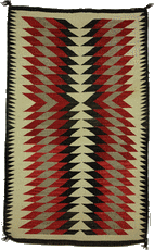
In the beginning, the Niłch'i Diyin ("Holy Wind") appeared as a luminous mist within the darkness of the primordial universe, with the aim of awakening the four Diyin Dine'é within the three lower worlds. This world was purely spiritual: physical matter remained to be formed, with the humans existing in a purely ethereal form.
Ni' Hodiłhił, the First World or Dark World, was centred on an island in the midst of four seas. This was the dwelling place of the Diyin Dine'é, the rulers of the seas and two Coyotes (singular: Mą'ii), as well as beings formed of mist and a number of other entities, the Air-Spirit People (with attributes of insects and bats). First Man and First Woman came into being in Ni' Hodiłhił, meeting one another having seen each other's fire. Eventually, the situation within Ni' Hodiłhił deteriorated, with fights breaking out between the inhabitants. They subsequently left by flying through an opening to the east.
Their destination was Ni' Hodootł'izh, the Second or Blue World, whose inhabitants were blue-grey mammals and birds, including blue swallows. The immigrants from Ni' Hodiłhił offended Táshchózhii, the Swallow Chief, who requested that they leave. First Man fashioned a wand from jet and other artefacts which enabled the people to walk on it to reach the next world via an opening in the south.
This Third or Yellow World, Ni' Hałtsooí, featured two rivers forming a cross and various Sacred Mountains, but no sun. This world was the home of Tééhoołtsódii and, after Mą'ii abducted her two children, she caused a deluge, forcing the people into the next world.
This Fourth or White World was known as Ni' Hodisxǫs, and was covered in water. Therein dwelt a host of monstrous forms known as naayéé'. The Sacred Mountains were recreated using soil from Ni' Hodootł'izh. It was here that First Man, First Woman and the Diyin Dine'é fashioned the sun, moon, stars and the seasons. Again, Mą'ii's antics made him the culprit in a great misfortune: he threw a stone into a lake, declaring that, if it sank, the dead would descent back into the prior world. Thus, death came into being.
Birth, too, was here though. Ni' Hodisxǫs saw the birth of Yoołgaii Asdzą́ą́, who later became Asdzą́ą́ Nádleehé ("Changing Woman"), who in turn bore the Hero Twins, Naayééʼ Neizghání and Tóbájíshchíní. It was their actions that brought the reign of the naayéé' to an end and enabled humanity to thrive. This species was brought into being by a number of creation events.
TEWA
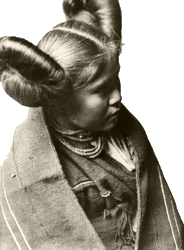
At the beginning of their existence, the human race dwelt in darkness beneath the ground. They grew restless and started to wonder if a better life awaited them elsewhere. To this end, upon the occasion of a visit from above by Mole, they interrogated him about the world above. Though blind, Mole admitted that the region above did have a more expansive feel to it. He offered to lead them upwards and they agreed to follow.
Eventually, they made it to the world above, but the dirt deposited from Mole's digging had permanently blocked access to their original homeland.
This new realm was full of light, which startled the people. They wished to return to the darkness but they heard the voice of Spider Woman, also known as Spider Grandmother, who instructed them to acclimatise slowly.
Once they saw the old beldam, flanked by her grandsons the War Twins, they were advised not to behave as they did, but to remain at peace, eschewing the use of weaponry. She pointed out the corn and taught them the arts of its cultivation, while pointing out some sacred mountains in the distance. She informed them that their rightful land lay to the south near Turtle Mountain (Sandia Mountain).
In these earlier times, the Tewa dwelt in a place in the north, where they were hard pressed by their enemies. This land was dark.
The warrior Long Sash led the ancestors of the Tewa from this place to the south. The journey was arduous, but it afforded an opportunity for Long Sash to instruct the Tewa in their mode of life. Their initial wanderings took them to Red Mountain, where the Comanche slew a number of them. This led some of them to create weapons.
Eventually, they arrived and found that the land was perennially bathed in light. The people who had completed the journey now began to fight among themselves, forcing Long Sash to bring an end to it by ordering them to rest.
After they decided to continue, Long Sash led them on to the region in which the Pueblo people live today. The remaining Tewa - a man and a woman - found a small turtle in the sand near the Rio Grande, which left tracks like those of Mole and which bore the insignia of Spider Woman on its back. Thus, they had found Turtle Mountain.
TOHONO O'ODHAM
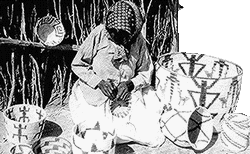
During its formative existence, the earth remained unfinished. The waters below and darkness above caused friction upon their surface. Within the darkness, there were strong winds, within one of which a child - First Born - came into being. One day, this child discoverd that some algae had adhered to him, from which he made termites. These gathered more algae, and First Born attempted to make a seat to prevent the wind from blowing it everywhere. He sang a magical song: -
Thus, the earth was made, whereupon Earth Medicine Man or First Born populated it with animals and plants. There was, however, no luminary above, and all remained in darkness. This caused the creatures to plead with First Born to fashion lights. First Born asked them to name the entity which would give them light, and they named it sun. Thereafter, First Born fashioned moon and stars, each following a course he set for them. Whereupon, First Born left the earth.
Some time later, the sky again came down and covered the earth, which resulted in the creation of I'itoi, the "Elder Brother" of the Tohono O'odham nation. This occurred twice more, giving rise to Coyote and Buzzard. I'itoi, Coyote and Earth Magician then began to create humanity, with I'itoi forming them from clay and giving them the "crimson evening." I'itoi placed the Tohono O'odham in the land at the centre of the earth, where they continued to dwell.
ZIA
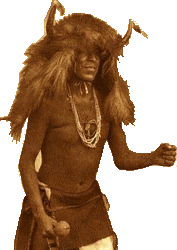
In the beginning, the lower world was the home of Sussistinnako, the spider. He drew a line from north to south and from east to west, placing parcels on either side whose contents are known only to Sussistinnako. He began to sing, causing the appearance of two women from the parcels. These were Now-utset and Utset (Ut'se't), the mothers of the Indians. Before long, other people had begun to appear, followed by the rest of the animal kingdom. Sussistinnako, meanwhile, kept up his song of creation until it was complete.
Yet the people lived in darkness. To rectify this, Sussistinnako created the Cloud People, Thunder People, Lightning People and Rainbow People to work for the people of the primordial earth, Ha-arts. He divided creation into six parts, each centred upon a spring in the middle of a great mountain from whose summit grew an enormous tree. These were as follows: -
- The Mountain of the North, topped by a spruce;
- The Mountain of the West, topped by a pine;
- The Mountain of the South, toppped by an oak;
- The Mountain of the East, topped by an aspen;
- The Mountain of the Zenith, topped by a cedar; and
- The Mountain of the Nadir, also topped by an oak.
The cosmos itself was also divided, this time into three plains: -
- Ha-arts (the earth);
- Tinia (the middle plain, domain of the rainbow); and
- Hu-wa-ka (the upper plain).
On Ha-arts, the people began digging into the earth to fashion shelters. Utset and Now-utset discussed among themselves, resolving to create light. They made the sun from an abalone shell, a white shell, red stone and turkis. They carried him to the east and set up camp there, then climbed a mountain and deposited the sun behind it. He ascended and took his course, bringing light and joy to the people. When he was afar, his face was blue, becoming brighter as he passed closer. He was surrounded by an enveloping mask, which covered his body.
Next, to light the night, the mothers made the moon from turkis, as well as yellow, black and red stones. Then they formed the Star People with their eyes of white crystal. When they remained in the world of Ha-arts, the Star People were gathered together in groups, rather than scattered as they are now.
The people lived happily for eight years, but the ninth was marked by heavy flooding, with the water causing the inhabitants to flee to the mountain tops. To allow their escape, Sussistinnako placed a reed at the top of a mesa to allow the people to travel to the world above. Many of the Star People were taken along in a sack.
Unfortunately, their way was barred by the floor of the world above. Sika the Locust was the first to burrow through on Utset's orders, followed by Badger. Reports back suggested that the world above was good. Deer, Elk and Buffalo confirmed Badger's report. Utset then committed the sack containing the Star People to Scarab, who opened it from curiosity, causing the Star People to fill the heavens. Once the last of the inhabitants, Turkey, made it through, the door was covered by a rock.
Later, the Zia returned to the land of Ha-arts, via an opening in the north. The land remained moist, and Utset called upon Cougar to solidify it. Cougar - and a number of other creatures - met with no success. Eventually, Sussistinnako told Utset that a woman of the Kapina clan (the Spider clan) try. She made a road of cotton from her body which she placed a few feet above the earth, enabling the people to travel. Next, a man of the Kapina came, making a lattice of wood which he threw to the four directions. This had the desired effect.
Soon, Utset was ready to depart, leaving power in the hands of a man from the Corn clan, giving him the title Ti'a'moni. She also dispatched six women to the six mountains to intercede with the Cloud People on behalf of the people of Ha'arts.
Time went on and the people came under the rule of a particularly savage Ti'a'moni, who, in order to prevent further population expansion, took to slaying all infants. Strife between men and women became more marked. Eventually, a total separation of the sexes - divided by a river - was implemented and, while the women pined for the men, the men seemed satisfied with the situation. By the fourth year, however, the men returned at the request of the Ti'a'moni, who had submitted to the entreaties of the women.
ZUNI
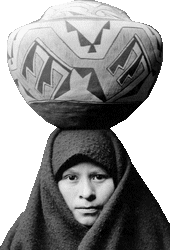
The Zuni recall that our era is merely the most recent in a series of ages, each of which was populated by a different set of beings. To begin with, the earth was a dark, watery place which was subject to repeated earth tremors. This early world was populated by marine monsters, with the ancestors of humans ekeing out a meagre existence in muddy caves on islands. These people are described as being goggle-eyed, with webbed feet, tails and bat-like ears. Eventually, the Twin Children of the Sun set about drying and solidifying the earth, which was done using a rainbow and arrows of lightning. At this point, the human ancestors emerged onto land, feeling the sunlight on their clammy skin and enabling them to evolve into the form we have today.
Life on land would not be easy, however: gigantic bears, lions and other creatures stalked the world, devouring the vulnerable ancestors of mankind, which led to the Twin Sons blasting them with lightning, causing them to turn into stone.
